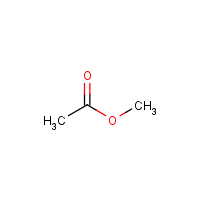Methyl acetate
Agent Name
Methyl acetate
CAS Number
79-20-9
Formula
C3-H6-O2
Major Category
Solvents

Synonyms
Acetate de methyle [French]; Acetic acid, methyl ester; Devoton; Ethyl ester of monoacetic acid; Methyl acetate; Methyl acetate (natural); Methyl acetic ester; Methyl ethanoate; Methylacetaat [Dutch]; Methylacetat [German]; Methyle (acetate de) [French]; Methylester kiseliny octove [Czech]; Metile (acetato di) [Italian]; Octan metylu [Polish]; Tereton; [ChemIDplus] UN1231
Category
Esters (<C12)
Description
Colorless liquid with a fragrant, fruity odor; [NIOSH]
Sources/Uses
Used as a flavoring agent and as a solvent in paint removers and lacquers; [ACGIH]
Comments
In the body, methyl acetate is hydrolyzed into methanol and acetic acid. It causes narcosis in animals exposed to high concentrations. "TLV Basis" is headache, dizziness, nausea, and damage to the ganglion cells in the retina; Main concern is conversion to methanol, which can cause permanent blindness; Eye damage has been reported after chronic exposure to methanol at 1200-8000 ppm; [ACGIH] Ethyl acetate is in the list of "Some volatile substances which may be abused by inhalation" published on the web site of the U.N. International Drug Control Programme, indicating its potential to cause narcosis in workers. [Reference #1] An eye and respiratory tract irritant; Inhalation of high concentrations can cause CNS depression and effects on the optic nerve leading to impaired vision; [ICSC] See "Methanol."
Reference Link #1
Biomedical References
Exposure Assessment
Skin Designation (ACGIH)
Insufficient data
TLV (ACGIH)
200 ppm
STEL (ACGIH)
250 ppm
PEL (OSHA)
200 ppm
MAK
100 ppm
IDLH (NIOSH)
3100 ppm
Excerpts from Documentation for IDLHs
Human data: It has been reported that concentrations of 10,000 ppm for a short time caused irritation which persisted after exposure stopped [Clayton and Clayton 1981].
Vapor Pressure
216 mm Hg
Odor Threshold Low
0.17 ppm
Odor Threshold High
1733 ppm
Lethal Concentration
LCLo (rat) = 32,000 ppm/4H
Explanatory Notes
IDLH = 10% LEL; Detection odor threshold from AIHA (mean = 180 ppm); Flash point = -10 deg C; VP from HSDB;
NFPA
may ignite at ambient temp
Adverse Effects
Neurotoxin
Acute solvent syndrome
Diseases, Processes, and Activities Linked to This Agent
Diseases
Occupational diseases associated with exposure to this agent:
Processes
Industrial Processes with risk of exposure: